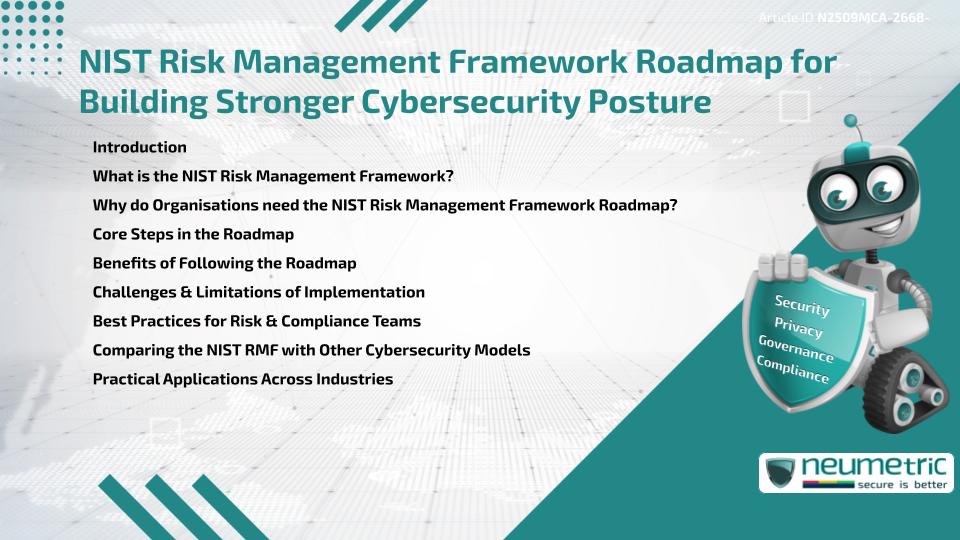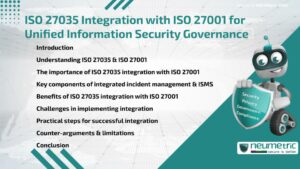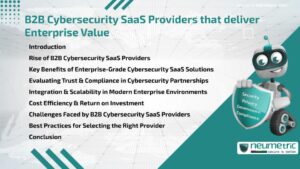Table of Contents
ToggleIntroduction
Enterprises today face sophisticated Cyber Threats & evolving Compliance Requirements. The NIST Risk Management Framework roadmap offers a structured path for strengthening Cybersecurity posture by aligning Risk Management processes with Regulatory & Operational needs. This article explains what the Framework is, why Organisations depend on it, the essential steps involved, benefits & limitations & how teams can apply it across industries for practical results.
What is the NIST Risk Management Framework?
The National Institute of Standards & Technology developed the Risk Management Framework [RMF] to help Organisations manage Information Security & Privacy Risks. Unlike Ad-hoc Security approaches, the NIST Risk Management Framework roadmap provides a repeatable structure for classifying systems, selecting & implementing controls & monitoring performance. According to NIST, the RMF integrates security into every stage of the system life cycle, making it a comprehensive tool for enterprises.
Why do Organisations need the NIST Risk Management Framework Roadmap?
Organisations use the NIST Risk Management Framework roadmap to:
- Identify Risks consistently across business units.
- Map Regulatory requirements like FISMA, HIPAA & GDPR into system controls.
- Build a culture of Accountability & Resilience.
- Demonstrate Compliance to Auditors & Stakeholders.
Without such a roadmap, teams may implement fragmented Security Measures, leaving critical gaps in protection.
Core Steps in the Roadmap
The NIST Risk Management Framework roadmap is structured around six (6) core steps:
- Categorise – Define the system & its data according to impact levels.
- Select – Choose appropriate Security & Privacy controls.
- Implement – Apply & document chosen Controls.
- Assess – Evaluate effectiveness through Testing & Audits.
- Authorise – Grant approval for system operation based on Risk analysis.
- Monitor – Continuously track & update Security posture.
These steps ensure that Cybersecurity is not a one-time event but an ongoing cycle of improvement.
Benefits of Following the Roadmap
Adopting the NIST Risk Management Framework roadmap provides multiple advantages:
- Strengthens organisational Resilience against cyber attacks.
- Streamlines Compliance with Federal & Industry Regulations.
- Improves communication between technical & business teams.
- Reduces duplication of efforts by standardising security processes.
- Enhances Trust with Partners, Customers & Regulators.
Challenges & Limitations of Implementation
Despite its benefits, the NIST Risk Management Framework roadmap has challenges. It can be resource-intensive, requiring skilled staff, time & funding. Smaller Organisations may find it difficult to adopt all steps comprehensively. There is also a Risk of over emphasis on Compliance Checklists rather than meaningful Security Outcomes.
Best Practices for Risk & Compliance Teams
To succeed with the NIST Risk Management Framework roadmap, teams should:
- Tailor the roadmap to organisational size & Risk profile.
- Use automation tools to streamline Monitoring & Reporting.
- Engage leadership to ensure Resources & Accountability.
- Train staff regularly on Security Control Implementation.
- Review & Update Controls in line with evolving Threats.
Comparing the NIST RMF with Other Cybersecurity Models
Frameworks like ISO 27001 & COBIT also guide Cybersecurity & Risk Management. However, the NIST Risk Management Framework roadmap distinguishes itself by being federally recognised & more prescriptive in its steps. While CIS Controls provide prioritised technical safeguards, RMF addresses Governance, Authorisation & Lifecycle Integration, making it broader in scope.
Practical Applications Across Industries
The NIST Risk Management Framework roadmap is not just for federal agencies. Healthcare providers use it to align with HIPAA, Financial firms apply it to satisfy SOX & PCI DSS requirements & technology companies use it to strengthen Cloud Security.
Takeaways
- Provides a structured, repeatable approach to managing Cybersecurity Risks.
- Aligns security with Compliance & Business Operations.
- Offers six (6) core steps that cycle continuously for improvement.
- Can be resource-intensive for smaller Organisations.
- Works best when tailored & integrated into daily practices.
FAQ
What is the NIST Risk Management Framework roadmap?
It is a structured approach developed by NIST to help Organisations manage Cybersecurity & Privacy Risks across system lifecycles.
Why is the NIST Risk Management Framework roadmap important?
It ensures consistent Risk Management, Compliance alignment & improved Resilience against Cyber Threats.
What are the six steps of the roadmap?
They are Categorise, Select, Implement, Assess, Authorise & Monitor.
Is the Framework mandatory?
Yes, for federal agencies under FISMA, but widely adopted voluntarily by private enterprises.
How does it differ from ISO 27001?
ISO 27001 focuses on building an Information Security management system [ISMS], while RMF provides prescriptive steps integrated into system operations.
What challenges do Organisations face with the roadmap?
Key challenges include resource demands, complexity & Risk of treating it as just a Compliance checklist.
Can Small Businesses adopt the NIST Risk Management Framework roadmap?
Yes, but they may need to scale it to their Risk profile & focus on essential steps due to limited resources.
Need help for Security, Privacy, Governance & VAPT?
Neumetric provides organisations the necessary help to achieve their Cybersecurity, Compliance, Governance, Privacy, Certifications & Pentesting needs.
Organisations & Businesses, specifically those which provide SaaS & AI Solutions in the Fintech, BFSI & other regulated sectors, usually need a Cybersecurity Partner for meeting & maintaining the ongoing Security & Privacy needs & requirements of their Enterprise Clients & Privacy conscious Customers.
SOC 2, ISO 27001, ISO 42001, NIST, HIPAA, HECVAT, EU GDPR are some of the Frameworks that are served by Fusion – a SaaS, multimodular, multitenant, centralised, automated, Cybersecurity & Compliance Management system.
Neumetric also provides Expert Services for technical security which covers VAPT for Web Applications, APIs, iOS & Android Mobile Apps, Security Testing for AWS & other Cloud Environments & Cloud Infrastructure & other similar scopes.
Reach out to us by Email or filling out the Contact Form…





